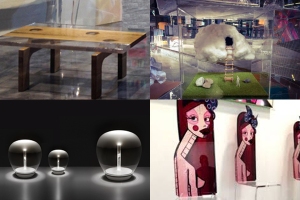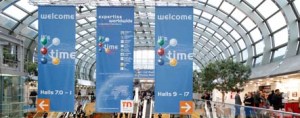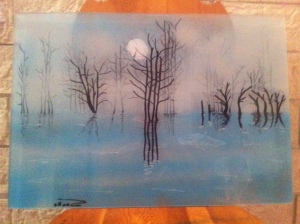Filed under: Uncategorized | Leave a comment »
Filed under: Uncategorized | Leave a comment »

acrylic and wood table , Empatia lamp by Artemide, “Atmospheres – Architectural Environments, Politecnico student, artist throne by Silvia Viganò
We met, walking around Milan, the Artemide showroom; they propose Inverted Shadows, a new lamp in three versions: wall, floor and suspension; the clear acrylic body accommodates a very small (16X16mm) linear extruded aluminium element, which contains the LED strips. In the second window instead Empatia is to become the main protagonist: a glas bubble that houses a LED light diffused by a cast acrylic rod.
“Coquette” by Silvia Viganò is a funny and original artist throne, made of transparent acrylic with a backrest that is the face of a woman; at the fair exposure we found a table worthy of note, a table that arises from the combination of transparency and brilliancy of acrylics and the naturalness and warmth of wood.
Finally, particular is the use of acrylic glass that the Politecnico di Milano has done to involve his students in the exhibition “Atmospheres – Architectural Environments” in the occasion of this design week. To every participant students has been made available a transparent acrylic cube of 25 cm per side, without one face. The guidelines were simple, it was necessary to communicate within this box or on its faces an environmental atmosphere, without specifying much more; so they could talk about an indoor environment, an imaginary space or an outdoor location, etc. This has allowed the designers to create very different and interesting interpretations of their personal environment.
credits:
http://atmospheres.polimi-cooperation.org/
http://www.artemide.com/home/index.action
Filed under: Acrylics, Architecture, Arts, Design, exhibition, Fashion, Innovation, lighting, Plastics | Tagged: acrylic chair, acrylic cube, acrylic lamp, acrylic table, fuorisalone, lighting, milan exhibition, salone del mobile | Leave a comment »
We can also recall the success of Kartell, wich made plastics its workhorse proposing it as a valid alternative to glass for its lightness, resistance and cheapness; today this success is still witnessed by one of the wider stand around the Salone del Mobile fair; in this stand the atmosphere that fills you is that of a past yet modern (first successful pieces are the one of the Seventies) and a modern which sometimes remind us the importance of the past (as the famous chair Louis Ghost, with its baroque shapes). Even today, it is enough to take a ride at the Salone del Mobile fair in Milan, or simply at the Fuori Salone (events and exhibitions that animate the entire city of Milan during the design week), to realize that the plastic in all its forms, including PMMA, it is still the unquestioned leader.
credits:
http://www.kartell.it/global.aspx
Filed under: Acrylics, Architecture, Design, Fashion, Innovation, Plastics | Tagged: acrylic chair, acrylic furniture, fuorisalone, lightness, past and modern, plastics, resistance, salone del mobile | Leave a comment »
PMMA, an industrial plastic material that was patented in the ’30s in Germany, was used as a new material for applications in the field of design already from the ’40s. In the interior design world, first successfull PMMA application results can be traced back to Ladislas Medgyès, who disegned bed-room furniture for Helena Rubinstein and to Lorin Jackson, who designed the furniture for Grosfeld House. But it is in the early 60s that designers start to exploit the advantages of plastics: the freedom of designing in various forms and a wide range of colors and finishes instead of an inexpensive and easy-to-use replacement for another material.
Filed under: Acrylics, Arts, Design, Fashion, Plastics | Tagged: acrylic furniture, acrylics, Design, plastic material | Leave a comment »
It was in the 70s , at the beginning of his carreer, that this artist began working for a short time at the Castiglione Olona Center Polymer Art: here he first experieced the use of methacrylate (acrilyc glass), which will become the preferred material of his works; through this material he can overcome the concept of bidimensionality: methacrylate is a plastic material with interesting properties of transparency and opacity, therefore able to hide or reveal a space that goes beyond the canvas. His works on acrilyc glass sheet sursprise for the complexity of their cromatics and compositional effects that follow one another through four or five methacrylate sheets; this complexity is obtained by almost fine dust incisions, thin shapes cut out of acrylic glass and filters attached to the panels with different inclinations that differently capture and refract light. The light and shadow effects are accompanied by colour obtained by the immersion of methacrylate items in a particular heated solution: the colored liquid penetrates inside the material so that it can’t be damaged by external agents. His experiments with this special material go beyond sculpture and painting, embracing also the world of architecture, with complex architectural compositions with a strong verticality which remind us of symbolic contents typical of Gothic art .
1) light harp: light acrylic and fiber optics sculpture
2) A flower around Gaia: sculptural methacrylate plastic
3) Il riccio: stratigraphic methacrylate structure with electric motor for the movement
4) Gothic nr 1: stratigraphic methacrylate structure
credits:
https://it-it.facebook.com/events/80966573267/
http://www.caldarelli.it/filippoavalle/bio.htm
Filed under: Acrylics, Architecture, Arts, painting, Plastics, Sculpture | Tagged: acrylic glass, acrylic glass sheet, methacrylate | Leave a comment »
At Daimler Contemporary, an art gallery in Postdamer Platz, Berlin, you can now find an interesting exhibition called ‘Conceptual Tendencies 1960s to Today II’ . This exhibition talk about Conceptual art, an artistic movement in which the concept or the idea involved in the work is more important than traditional aesthetic and material roles. Here you can see some interesting works made by the artist Natalia Stachon in which she use acrylic glass in contrast with steel: some welded steel girders ran horizontally across the entire floor, the perception of which transformed the space into a spatiotemporal energy with a quality of openness, and two groups of three 250 cm long acrylic glass tubes, held together by wide belts, hunged from the ceiling like a balance beam. What is emphasized here is the fact that the stages that Natalia Stachon conceives for her artworks are neither motifs nor the arena for ‘sculptural narratives’. Instead, they are a self-reflexive locus for art as art: the artworks reflect their derivation and their redirection, they make us acquainted with their placeholder position as ‘variables in an experimental protocol’, and this ensures an openness in the way the space is experienced.
credits: http://collection.daimler.com/contemporary/contemporary_e.htm
Filed under: Acrylics, Arts | Tagged: acrylic glass, acrylic glass art | Leave a comment »
K 2013, the International Trade Fair for
Plastics and Rubber, is going to take place in Düsseldorf from 16-23 October,
and it will be the undisputed flagship event for plastics again. The focus of
its attention will be not only on optimised standard raw materials, but also on
bio-, advanced and reinforced plastics and the latest developments in the
fields of structural materials and functional polymers for futuristic
applications. To illustrate the many improvements already attributed to plastic
products in every day life and their potential contribution to future
challenges, a special show with the title “Plastics move the world” will
be realized in hall 6. It takes a broad approach to the meaning of the word “to
move”. It includes not merely the direct contributions of plastics to different
areas of mobility, but also emotional aspects generated by art and design, and
their potential for solving future problems such as demographic growth,
increasing energy consumption and climate change.
 We also think you could find interesting the Innovation Compass instrument, available from September: all the innovations
We also think you could find interesting the Innovation Compass instrument, available from September: all the innovations
that K 2013 exhibitors want to present. Don’t miss it!
credits: http://www.k-online.de/
credits: http://www.gevacril.com/
HALL 5; E04
Filed under: Acrylics, Innovation, Plastics | Tagged: futuristic applications, Innovation, K 2013, latest developments | Leave a comment »
3D-printing is a form of additive manufacturing where a 3-dimensional object is created by laying down multiple layers of a material. The printer works taking a 3d file from a computer, it transforms the file in more sections; every small section is printed one above the other, obtaining the object.
3D-printing touches a diverse set of industries, professions and activities and it involves even the plastics world: most desktop 3D printers call for some type of plastic 3D print material, specifically ABS filament or PLA filament. ABS is the most ‘established’ filament, having been refined in other industries for decades. Being less sensitive to heat, ABS requires higher extrusion temperatures and a heated bed. This makes it ideal for jobs where temperature needs to be finely tuned. PLA has taken significant ‘material-share’ in recent years; its extrusion-temperature is much lower than ABS, and most often doesn’t require a heated bed.
3D-printing is bursting with innovation, it has revolutionized the speed, cost and accessibility of prototyping. No longer additive manufacturing is restricted to fortunate few companies. Now, small firms and institutions, individual engineers and inventors, and even do-it-yourself tinkerers, can bring their concepts or ideas into reality. You can easier realize a prototype or every day objects like sculpture, jewelry, furniture, machine parts, medical casts (dental crowns), recreational goods (snowboards)….
Here you can see two examples: the first image represents the printing and the second one represents the created object.
credit: http://3dprinterhub.com
Filed under: Innovation, Plastics | Tagged: #3d printing, #abs | Leave a comment »
We newly found these amazing street art works in an art gallery in Milan: The artist, SnakeReverse told us that they are made with stencils on cast acrylic blocks. The works are “stenciled” on the back of the block, so that its thickness create a third dimension effect. This unique and unusual technique looks great. We hope to discover more about this artist. In the meanwhile, enjoy…
Filed under: Acrylics, Arts, Plastics | Tagged: acrylics, PMMA, stencil, Street Art | Leave a comment »